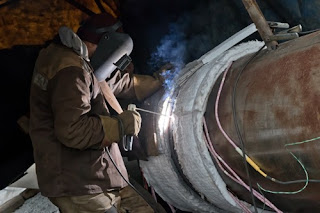 |
| Pre-heating and metal prep before welding a large section of pipe. |
First, it increases the temperature of the target material, resulting in a controlled (slower) cooling rate of the target material, as well as that of the weld. Thicker areas of steel, typically 1/2 inch or greater, and high-strength low-alloy steels (HSLA) are prone to the formation of weakened crystalline microstructures if the weld cools too quickly. These weakened crystalline microstructures are called martensite. Martensite is a steel crystalline structure critical to the steel's hardness and strength; too much martensite leaves steel brittle; too little leaves it soft.
When welding, martensite can form in the newly deposited weld metal, the base target material, or
the HAZ (heat-affected zone). Applying the proper amount of pre-heat prior to welding will assist in preventing the formation of martensite. Pre-heat temperatures and soak times are dependent on the target materials type, thickness, grade, and carbon equivalency. There is ample temperature and time pre-heat information available on the Internet and from industry associations, and one should refer to this information prior to welding.
 |
| Ceramic mat heaters used to pre-heat pipe spool piece. |
Uniformly preheating the target material prior to welding, and then insulating the target area after welding, provides an adequate cooling rate allowing hydrogen to diffuse out of the weld joint, preventing hydrogen cracking.
For more information about the equipment and processes required for weld pre-heating, contact Hotfoil-EHS, a world leading manufacturer of heat treatment equipment. They can be reached by calling 609-588-0900 or visit their web site at https://hotfoilehs.com.



